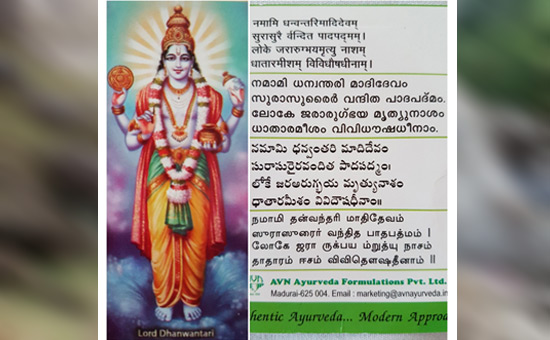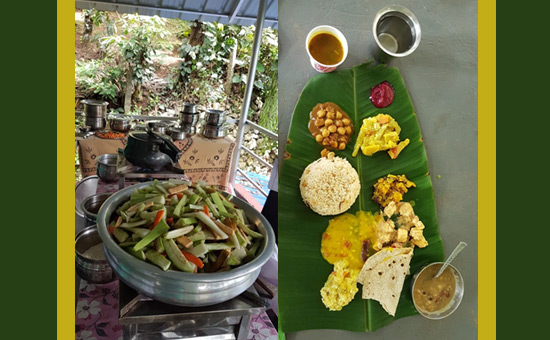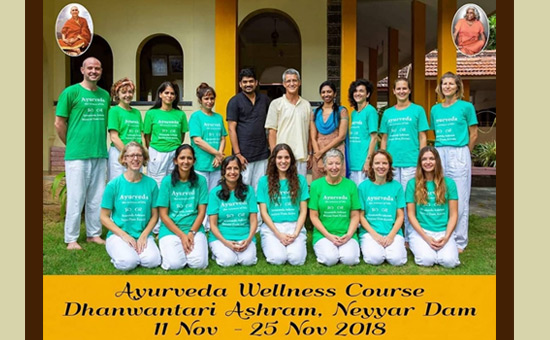-
Article is
about the basics of Ayurved, three Doshas and key learnings from course.
I enjoyed an
informative two-week intensive course in the tropical splendour of Kerala and
decided to share my experiences and learnings.
The two-week
Ayurvedic Wellness course was held within the Sivananda Yoga Vedanta
Dhanwantari Ashram in the Sivananda Institute of Health, and I experienced the
peace and healing environment at a place of sacred learning. The course was directed
by Dr. P. R. Vishnu, supported by a team of assistants and massage therapists.
According to
their website,
“Learn to apply the fundamentals of ayurvedic theory and simple therapeutic
medicinal and massage treatments. Hands-on practical workshops give you the
opportunity to prepare home remedies, and apply ayurvedic nutrition principles
to cooking. You will look at how to develop a preventative lifestyle where
consideration is given to age, seasons, and climate and will gain invaluable
insight into how to change your life-style habits for better health. You will
take home a broadened and expanded outlook on how to create a lifestyle based
on good health and mental well-being, both for yourself and family and friends.”
 Pranams to Lord Dhanvantari, the deity of Ayurveda.
Pranams to Lord Dhanvantari, the deity of Ayurveda.
We were introduced to
Ayurveda, a Bharatiya (Ancient Indian) holistic approach to attaining and
maintaining good health. The teachers Dr. Vishnu (Nair) and Dr. Priya (as
affectionately called by their first names) were very knowledgeable and
helpful.
Ayurveda means the Science of Life
Ayurveda survived through two
sets of original Sanskrit texts each consisting of three books:
Bruhattrayi: Three big books: Caraka Samhita (600 B.C.), Susruta Samhita
(500 B.C.) and Vaghbata Samhita (600 A.D.)
Laghutrayi: Three small books: Madava nidana (900 A.D.),
Sarangdara Samita (1300 A.D.) and Bhava Prakasa (1600 A.D.)
I gained a beginner’s
understanding of the principles of Ayurveda, so I could adjust my lifestyle, and
dietary choices to help enhance the health of my friends, family colleagues,
yoga students and myself.
The two most important aims of Ayurveda are: To maintain the health of healthy people AND To cure the diseases of sick people.
We learned the main principle of Tridosha - Vata, Pitta and Kapha (one’s
natural state of being and imbalances) and simple therapeutic medicinal
treatments.
The Panchmahabhutas - five great elements, Akasha-Ether, Vayu-Air, Agni-Fire, Jal-Water and Prithvi-Earth as expressed through Vata,
Pitta and Kapha are essential to life, working together to create health or produce disease.
We are all made up of unique proportions of Vata, Pitta and Kapha. These ratios of the Doshas vary in each individual and because of this Ayurveda sees each person as a special mixture that accounts for our diversity.
Ayurveda gives us a model to look at each individual as a unique makeup of the three doshas and to thereby design treatment protocols that specifically address a persons health challenges. When any of the doshas become accumulated, Ayurveda will suggest specific lifestyle and nutritional guidelines to assist the individual in reducing the dosha that has become excessive. Also herbal medicines will be suggested, to cure the imbalance and the disease.
Understanding this main
principle of Ayurveda, it offers us an explanation
as to why one person responds differently to a treatment or diet than another
and why persons with the same disease might yet require different treatments
and medications.
Dr. Vishnu took one look at me
and my lively nature and said to the class, “Look at her, she is a pure Vata
type”. I was stunned at his clarity and have been joyously following a Vata-
pacifying lifestyle and diet since then. I understood my love for travel, dance
and creativity as Vata strengths.
The three Doshas possess
qualities and their increase or decrease in the system depends upon the similar
or antagonistic qualities of everything ingested.
Vata is dry, cold, light, mobile, clear, rough and subtle.
Pitta is slightly oily, hot, intense, light, fluid, free flowing and foul smelling.
Kaptha is oily, cold, heavy, stable, viscid, smooth and soft.
Both Vata and Pitta are light and only Kapha is heavy. Both Vata and Kapha are cold and only Pitta is hot. Both Pitta and Kapha are moist and oily and only Vata is dry.
Anything dry almost always increases Vata, anything hot increases Pitta and anything heavy, Kapha. For example:
Puffed rice is dry, cold light and rough - overindulgence in puffed
rice therefore is likely to increase Vata in the over indulger.
Mustard oil is oily, hot, intense, fluid, strong-smelling and liquid
and increases Pitta in the consumer.
Yoghurt, which, being creamy, cold, heavy, viscid, smooth and soft, is the very image of Kapha, adds to the body's Kapha when eaten.
Other basic principles learned included:
Dhatus - These are the basic tissues which maintain and nourish the body. They are seven in number namely- rasa (chyle), raktha (blood), mamsa (muscles), meda (fatty tissue), asthi (bone), majja (marrow) and sukla (reproductive tissue). Proper amount of each dhatu and their balanced function is very important for good health.
Mala - These are the waste materials produced as a result of various metabolic activities in the body. They are mainly urine, feces, sweat etc. Proper elimination of the malas is equally important for good health. Accumulation of malas causes ama- metabolic toxin and thereby many diseases in the body.
Agni - Importance of the digestive fire responsible for digestion and transforming one material to another.
We also learned and performed
Ayurvedic massage and cooking.
 Ayurvedic cooking class demonstration: mixed vegetables left, channa masala, right. Ayurvedic Thaali we each got on
banana leaf that we prepared together in class.
Ayurvedic cooking class demonstration: mixed vegetables left, channa masala, right. Ayurvedic Thaali we each got on
banana leaf that we prepared together in class.
We also looked at a preventative
lifestyle with consideration given to the daily routine, seasons, climate and
age. Dinacharya, the daily routine
was given the most importance. We were also encouraged to follow the ashrams
daily yogic routine including meditation, chanting, asana and pranayama.
I enjoyed the hands-on
practical workshops giving us the opportunity to prepare home remedies, and apply ayurvedic nutrition
principles to cooking. We took home a broadened and expanded outlook on how to create a lifestyle based on good health and mental well-being.
 Author is pictured
in the front row, third from left.
Author is pictured
in the front row, third from left.
Upon my return home I have been
cooking Ayurvedic Khitchadi daily. I regularly do Ayurvedic head self-massage
with coconut oil. I also do Dinacharya: oil pulling with sesame or coconut oil
two to three times per week for sparkling white teeth even though I am fond of
constant cups of Ayurvedic masala chai!
The process itself is straightforward. Take a tablespoon of sesame oil and then swish it around in your mouth non-stop for 20 minutes. When the oil is in your mouth it is gathering bacteria and extracting that bacteria. After the 20 minutes is up you spit out the oil in garbage, rinse your mouth with water, and then brush your teeth. This ensures that there won’t be any bacteria lingering around after the pull.
Please take this
course to attain and maintain perfect health, and also so you can learn tasty recipes
to cook and eat at home.
I highly recommend
this two-week course to everyone!
To know more about Dhanwantri Ashram
Contact guestindia@sivananda.org
+ 91 94956 30951. Course Registration yogaindia@sivananda.org
+ 94465 80764.
How to reach and location – The ashram is 33 kms from Trivandrum Airport. Taxi from airport to the ashram cost Rs 1000-1200/. “The Ashram faces Agastya Peak. According to tradition,
Agastya, a sage of the Vedic period, continues to meditate here on this
mountain. The air is still, the landscape unspoiled and untouched by the hustle
of city life. Panoramic views across the Sahyadri mountain range are only a
short walk away.”
To read all
articles by author
Author was born in India and lives
in Ontario, Canada. She is an Artist, Writer, Classical Hatha Yoga Teacher,
Classical Indian Musician & Dancer, Sanskrit Scholar, Reiki Master, Nature
Lover, and retired Engineer.
Also read
1 Course
Outline
2 Introduction
to Ayurveda